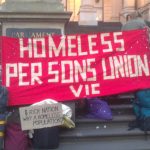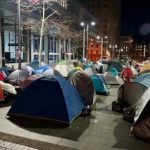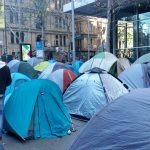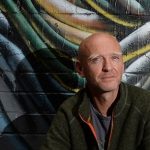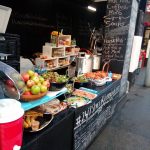Good People Break Bad Laws: Rough Sleepers
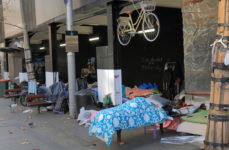
In terms of the law, people who are forced to sleep out on the streets are already on the wrong side of it, seemingly because they have no fixed address. Indeed, the 334 rough sleepers counted in the City of Sydney last month are simply criminalised by default.
Sleeping rough can guarantee intensified policing. Being moved on can get to be a part of daily life. Places where the homeless are camping together can be busted up. And even having a drink can be problematic, as consuming alcohol in the park or on the street is often a crime.
It’s not like things are getting any better either. Recent years saw then Melbourne lord mayor Robert Doyle move to ban sleeping rough in his city in early 2017. The plan was eventually dropped after United Nations condemnation.
And after a very public tit for tat between the NSW government and the City of Sydney over responsibility for the Martin Place Tent City, the Berejiklian government decided to rush through new laws that forced the rough sleepers to vacate the public square.
RMIT homelessness professor Guy Johnson explains that people sleeping outside only make up about 20 percent of the overall homeless population. But, while they may not be the majority, they’re certainly bearing the brunt of a society that treats they’re circumstances as criminal.
Pushing them out
“The City of Sydney has unambiguously had a policy since the mid-90s of trying to move homeless people out,” said frontline homelessness advocate Lanz Priestley. “There’s no consideration for Sydney to house homeless people, other than a token solution.”
“They tend to point to housing estates somewhere else, whether that be the traditional estates or the community model, which is problematic in itself,” he told Sydney Criminal Lawyers.
The City of Sydney website sets out that it’s the only council in NSW to run a specialist homelessness unit, which was launched in 1984. Operating on a 7 days a week basis, the homelessness unit aims to reduce rough sleeping by putting those on the street in touch with the right services and support.
However, according to Priestley, the purpose of the homelessness unit is to manage rough sleepers in the local government area in response to issues raised by ratepayers. And there’s no consultation with the actual people doing it rough.
“They’re doing it in consultation with the poverty industry,” Mr Priestley continued. “They’re doing it in consultation with a whole lot of other external groups, without asking homeless people what the solutions are that they want.”
Moving them on
The NSW government introduced the Protocol for Homeless People in Public Places in 2000. It sets out that homeless people have the same rights as all citizens in public places, and government organisations, including the NSW Police Force, should treat them accordingly.
But, as Priestley puts it, “that doesn’t mean it always happens”. And when asked about laws that impinge upon homeless people unfairly, he pointed to move on powers, which were introduced in the 1990s.
Section 197 of the Law Enforcement (Powers and Responsibilities) Act 2002 (NSW) (the LEPRA) provides police with the power to direct people to move on in public places if an officer believes on reasonable grounds that the person is obstructing, harassing, intimidating or causing fear to others, or they’re supplying or buying prohibited drugs.
And section 199 of the LEPRA provides that an individual who refuses to comply with such an order can be fined $220.
Word from the street
As Priestley tells it, move on orders were first used in the late 90s to deal with homeless people sleeping in the lanes around Woolloomooloo’s Matthew Talbot Hostel in an effort to move the rough sleepers out of the city centre.
“Cops would go up to them and say, “move on”. The guy would go to pick up his gear and be arrested for failing to follow a move on order,” Priestley explained. “They were given a court date two years down the track, and a 10 kilometre exclusion from the Matthew Talbot”, as part of their bail.
“The effect of that was that without going to court, they excluded these people who were getting these move on orders from the city,” he added.
Other tricks of the trade that Priestley recalls are NSW police officers repeatedly searching homeless people at Central’s Belmore Park until they’d leave for good, along with people being held on remand for a longer period of time than the maximum penalties that applied to the minor charges they were facing, only to have the prosecution drop them after they’d served the time.
Pushing them along
Mr Priestley founded the Martin Place Tent City in late 2016. Initially, it was in response to women sleeping on the street reporting that they didn’t feel safe, and that men had been trying to sexually assault them. The setup provided a secure place for the homeless to spend the night and get a meal.
By August 2017, Tent City numbers had swelled and NSW premier Gladys Berejiklian had complained that the rough sleepers made her feel “completely uncomfortable”. So, her government decided to rush through new move on powers to get rid of them.
The aim of the Sydney Public Reserves (Public Safety) Bill 2017 (NSW) was “to deal with an occupation of a public reserve in the City of Sydney that interferes with the reasonable enjoyment of the rights of the public or that is unlawful and, in particular, to deal with the unauthorised camp site at Martin Place”.
“My reaction then and now remains that it’s an absolute shame that as a kneejerk reaction, they could pass laws like that with such haste,” Priestley said, “instead of passing laws that solve homelessness.”
The new laws enabled police to move on people deemed to be hindering the enjoyment of others in a public reserve, as well as seize their belongings. Failure to comply with such an order can result in a $220 fine and trying to prevent officers from taking one’s belongings incurs a fine of $2,200.
And facing these enhanced laws, the rough sleepers left Martin Place, prior to NSW police moving in.
Preventative measures
Mr Priestley relates that at present, he’s been seeing a different cohort of rough sleepers on the city streets. These are people who only find themselves without a home for short periods of time – usually under six weeks – before they sort their issues out and are back off the streets.
The long-term social justice activist is still running his street kitchen once a fortnight in Martin Place. And for every other night, there are different groups doing the same.
And as for the issue of homeless people in this state, he advises that authorities should be looking at the bigger picture, rather than “parking the ambulance at the bottom of the cliff”, there should be moves to stop people becoming homeless in the first place.
“We need to work towards a point in time when there’s not the possibility of becoming homeless,” the unofficial mayor of Martin Place concluded. “And I don’t think it’s an impossibility to build that.”


